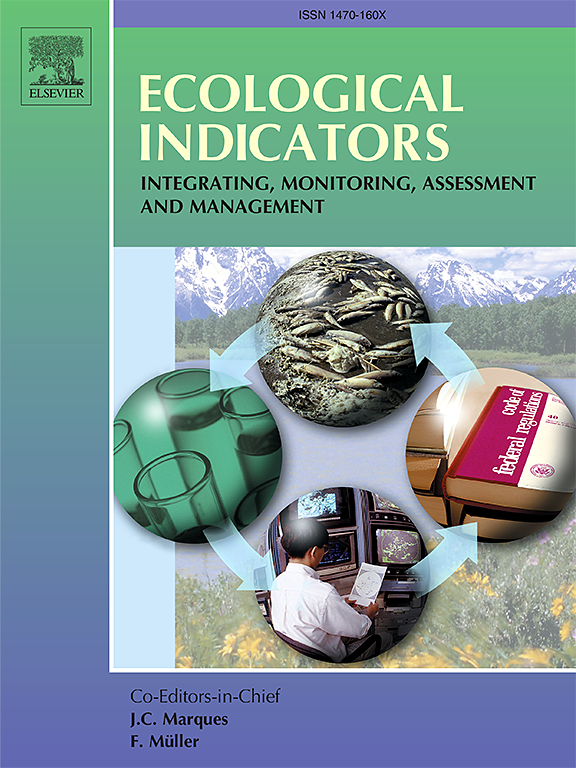Eutrophication promoted the change of macrophyte community from R strategy to C strategy in Lake Taihu
IF 7
2区 环境科学与生态学
Q1 ENVIRONMENTAL SCIENCES
引用次数: 0
Abstract
Functional traits effectively reflect plants’ ecological strategies in response to environmental changes. This study investigated how lake eutrophication influences macrophyte communities ecological strategies by analyzing leaf functional traits along the eastern littoral zone of Lake Taihu. Using Grime’s CSR framework (C: competitive; S: stress-tolerant; R: ruderal), we compared strategies among different macrophyte life forms (submerged, floating-leaved, and emergent) across a eutrophicaiton gradient. The study sites exhibited varying degrees of eutrophication (from mesotrophication to heavy eutrophication), with significant differences in nutrient contents and light availability. The macrophyte community was predominantly characterized by C and R strategies, with dominance shifting from R to C as eutrophication increased. Different life forms showed distinct responses: Submerged macrophyte transitioned from R to C strategies, floating-leaved macrophytes decreased C strategies proportion with increased S strategies while emergent macrophytes remained stable. Environmental factorss influenced community strategies indirectly through macrophyte traits, with C and S strategies negatively correlation with underwater light availability but positively with nutrient levels. while R strategy showed opposite correlations.This study revealed that reduced underwater light availability, rather than increased nutrient levels,was the primary driver of changes in macrophyte ecological strategies under eutrophication.

富营养化促进了太湖大型植物群落由R策略向C策略转变
功能性状有效地反映了植物对环境变化的生态策略。本研究通过分析太湖东岸叶片功能特征,探讨湖泊富营养化对大型植物群落生态策略的影响。使用Grime的CSR框架(C: competitive;S:合资公司;(R: ruderal),我们比较了不同的大型植物生命形式(淹没、浮叶和涌现)在富营养化梯度上的策略。研究点呈现不同程度的富营养化(从中营养化到重度富营养化),养分含量和光效度差异显著。大型植物群落以C和R策略为主,随着富营养化程度的增加,优势从R向C转移。不同的生命形式表现出不同的响应:沉水植物从R策略向C策略过渡,浮叶植物减少C策略比例,增加S策略比例,而应急植物保持稳定。环境因子通过大型植物性状间接影响群落策略,C和S策略与水下光有效性呈负相关,与养分水平呈正相关。而R策略则表现出相反的相关性。该研究表明,水下光照利用率的降低,而不是营养水平的增加,是富营养化条件下大型植物生态策略变化的主要驱动因素。
本文章由计算机程序翻译,如有差异,请以英文原文为准。
求助全文
约1分钟内获得全文
求助全文
来源期刊

Ecological Indicators
环境科学-环境科学
CiteScore
11.80
自引率
8.70%
发文量
1163
审稿时长
78 days
期刊介绍:
The ultimate aim of Ecological Indicators is to integrate the monitoring and assessment of ecological and environmental indicators with management practices. The journal provides a forum for the discussion of the applied scientific development and review of traditional indicator approaches as well as for theoretical, modelling and quantitative applications such as index development. Research into the following areas will be published.
• All aspects of ecological and environmental indicators and indices.
• New indicators, and new approaches and methods for indicator development, testing and use.
• Development and modelling of indices, e.g. application of indicator suites across multiple scales and resources.
• Analysis and research of resource, system- and scale-specific indicators.
• Methods for integration of social and other valuation metrics for the production of scientifically rigorous and politically-relevant assessments using indicator-based monitoring and assessment programs.
• How research indicators can be transformed into direct application for management purposes.
• Broader assessment objectives and methods, e.g. biodiversity, biological integrity, and sustainability, through the use of indicators.
• Resource-specific indicators such as landscape, agroecosystems, forests, wetlands, etc.
 求助内容:
求助内容: 应助结果提醒方式:
应助结果提醒方式:


